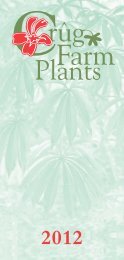downloadable catalogue - Crug Farm Plants
downloadable catalogue - Crug Farm Plants
downloadable catalogue - Crug Farm Plants
You also want an ePaper? Increase the reach of your titles
YUMPU automatically turns print PDFs into web optimized ePapers that Google loves.
within this group of woody twinning climbers that encompass the<br />
showiest of the genus. Possessing all the admirable qualities of the<br />
group with the added attraction of deep blood red flowers in this<br />
species. Staying within the group S. rubriflora 'Bodnant Redberry'<br />
was named formally in our 2012 plant list, as a female clone that we<br />
acquired some time ago from Bodnant Gardens. It’s such a shame<br />
that all of the male plants we purchased turned out to be female as<br />
well! If the professionals cannot tell the difference what hope is<br />
there? Our latest find is S. perulata FMWJ13100 with more<br />
persistent thicker textured foliage while the flowers are recorded as<br />
being yellow or red. It was an incredible feeling after scaling one of<br />
the precarious limestone pinnacles that we find in northern<br />
Vietnam, pushing through the undergrowth and emerging in a<br />
magical grove filled with the long strings of red fruit some<br />
highlighted by ribbons of bright sunlight. Schizophragma appears<br />
to be going through a nomenclature catching up period even more<br />
so than their hydrangea counterparts. None of the following are<br />
new entries in their own rights, but merely name changes. Hence<br />
S. fauriei is recognised at species level, while S. hydrangeoides v.<br />
concolor BSWJ5954 is recognition at varietal level for the forms we<br />
find growing in Kyushu with chalky white undersides to the<br />
foliage, as found in the cultivar 'Moonlight'. S. hydrangeoides v.<br />
taqueti BSWJ8771 is the variety that was distributed as quelpartensis<br />
at either species or varietal level. S. hydrangeoides v. ullungdoense<br />
BSWJ8505 is a new variety covering the distinct variety that is<br />
endemic to the Korean island of Ullüngdõ. Hailing from another<br />
island this time the Japanese Yakushima, S. hydrangeoides v.<br />
yakushimense BSWJ6119 is deemed distinct enough to attain<br />
varietal status. S. integrifolium BWJ8150 on the other hand is my<br />
bad penny, undergoing what should be its final identification.This<br />
is the problem when you run out of suitable wall space for planting,<br />
although after gutting a suitable barn we have finally managed to<br />
plant a specimen. Sinofranchetia chinensis DJHS4117 is another<br />
gift from our friend in Seattle. Where its chalk covered twinning<br />
stems have formed a large tangle of plants by the entrance to his<br />
new estate. Sorbus pseudovilmorinii is one of many species<br />
entrusted to us by Ness BG. This pink fruiting slender small tree<br />
will be valued in smaller gardens, particularly in the drier areas of<br />
the country. Requiring more space S. sargentiana EGM291 is well<br />
appreciated for those distinct sticky winter buds and red summer<br />
fruit. Maybe less familiar to most is S. setschwanensis BWJ8053<br />
which has been growing in our fields for some time, only forming<br />
a single stemmed slender shrub for us to date with delicately small<br />
glossy pinnate leaves availing some interesting autumnal hues as<br />
well as corymbs of white fruit. Spiraea blumei CWJ12829 was<br />
acting more like a perennial where we found it growing on<br />
irregular cliffs and ledges, mostly with a pendant habit in those<br />
conditions. Giving us a glimpse of the pale undersides to the small<br />
deeply indented almost palmate small leaves, some plants still<br />
59



